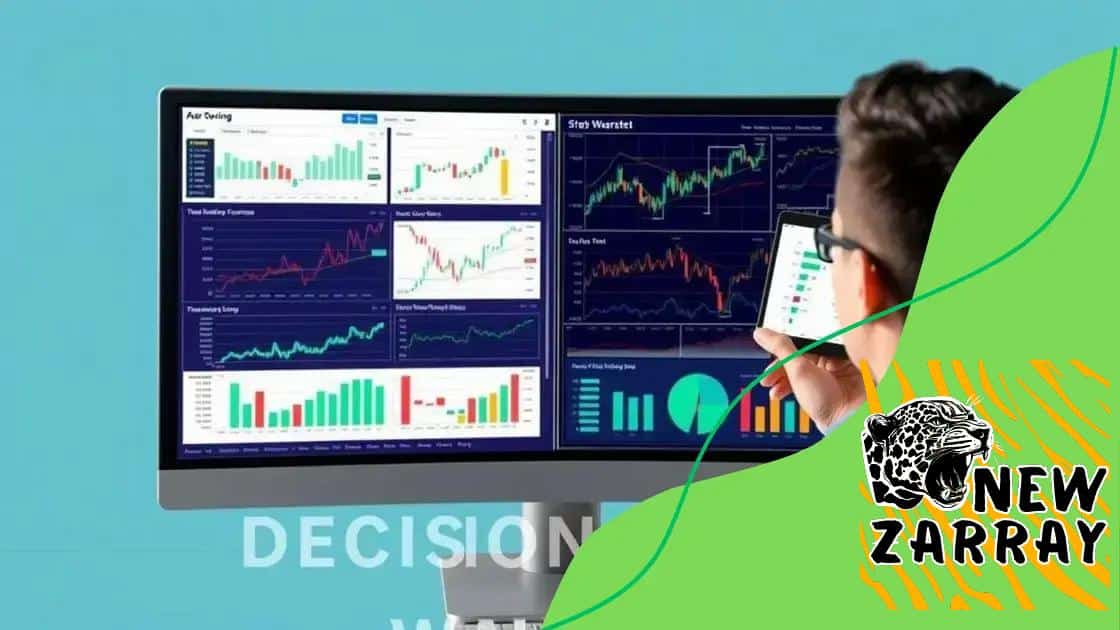AI-powered stock market forecasting tools: your guide

AI-powered stock market forecasting tools enhance trading strategies by providing real-time data analysis, improving prediction accuracy, and integrating large datasets for informed decision-making.
AI-powered stock market forecasting tools are changing the way investors make decisions. Have you ever wondered how these advanced technologies can predict market trends? In this article, we’ll explore their workings and benefits.
Understanding AI in stock market forecasting
Understanding AI in stock market forecasting is key to harnessing the full potential of financial technologies. AI uses complex algorithms and data analysis to predict stock trends and movements, which helps traders make informed decisions.
How AI Works in Forecasting
AI systems analyze vast amounts of historical data to identify patterns and correlations. By utilizing machine learning techniques, they continuously improve their predictions based on new data. As more data is fed into the system, its accuracy enhances significantly.
Key Components of AI Forecasting Tools
- Data Collection: Gathering historical stock data and news content.
- Machine Learning Algorithms: Employing statistical models to identify trends.
- Real-Time Analysis: Processing data instantly to provide timely insights.
These tools often integrate various data sources, including social media sentiment, economic indicators, and market news. The ability to analyze these factors collectively allows AI to predict price movements with greater precision.
Furthermore, AI-powered tools can simulate different market conditions and test strategies, helping investors understand potential risks. Many trading platforms now offer these AI tools, making it easier for both novice and experienced traders to enhance their strategies.
Benefits of Using AI for Forecasting
By leveraging AI, investors can access intuitive insights into market behavior. This technology not only saves time but also reduces human error. Here are a few benefits:
- Improved accuracy in predictions
- Faster decision-making processes
- Ability to analyze large sets of data quickly
- Reduced costs through automation
Overall, embracing AI in stock market forecasting can transform the way traders operate. The combination of speed, efficiency, and accuracy is unmatched by traditional methods, making it a vital tool for anyone serious about investing in today’s dynamic financial landscape.
Key benefits of using AI tools
Key benefits of using AI tools for stock market forecasting are substantial and can significantly enhance trading strategies. One of the standout benefits is increased accuracy. AI algorithms can analyze vast amounts of data quickly and efficiently, identifying patterns that might not be visible to the human eye.
Speed and Efficiency
AI tools process data in real-time, allowing traders to react swiftly to market changes. This speed reduces delays in decision-making, which can be crucial in volatile market conditions. With AI, investors are equipped to make informed choices almost instantly.
Data Analysis
Another benefit is the ability to analyze numerous data points simultaneously. Traditional methods are often limited to smaller datasets. AI can consider various factors—such as historical data, market trends, and even social sentiment—to provide a comprehensive analysis. Here are some important aspects of AI data analysis:
- Multi-source data integration: AI tools pull data from various sources, including news, social media, and financial reports.
- Predictive analytics: They use statistical models to forecast future market movements.
- Enhanced insights: AI delivers deeper insights for better trading decisions.
Moreover, AI tools help reduce human emotion in trading. Emotions can lead to irrational decision-making, but with AI, strategies are based on data and analytics, making the process more objective.
Cost Efficiency
Using AI also reduces operational costs. Automation of routine tasks means that traders can focus on strategic decision-making rather than mundane data management. This not only saves resources but also enhances productivity.
Lastly, AI tools offer continuous learning capabilities. They adapt to market changes and fine-tune their predictions based on new data, ensuring that users always have access to the latest insights. Overall, leveraging AI tools allows traders to enhance their strategies, minimize risks, and optimize their investment returns.
How to choose the right forecasting tool

How to choose the right forecasting tool for stock market analysis is crucial for making informed investment decisions. With many options available, it’s important to consider several factors that contribute to an effective tool.
Identifying Your Needs
Before selecting a tool, evaluate your specific needs. Are you a long-term investor or a day trader? Each type of trading may require different features. Knowing your trading style helps narrow down options. Additionally, consider what data is most relevant to you, such as pricing trends, trading volume, and news impacts.
Evaluating Features
Examine the features each forecasting tool offers. Here are some important aspects to consider:
- User-friendly interface: The tool should be easy to navigate, especially for beginners.
- Customizable options: Look for tools that allow you to adjust settings based on your preferences.
- Real-time data: Ensure the tool provides up-to-date information for accurate predictions.
Analyzing these features helps ensure the tool aligns with your requirements. Remember, a more complex tool isn’t always better; it should simplify your analysis process.
Cost Considerations
Another key factor is the cost of the forecasting tools. Some tools offer free features, while others come with subscription fees. It’s essential to find a balance between functionality and affordability. Think about whether the investment will yield profitable results that justify the cost. Consider starting with a trial version if available. This allows you to test the tool without commitment.
Seeking Reviews and Recommendations
Research tools by reading user reviews and seeking recommendations from fellow traders. Learning about others’ experiences can provide insights into the tool’s performance and reliability. Additionally, check online forums and trading communities where people discuss their favorites. This will help you make an informed choice.
Ultimately, selecting the right forecasting tool combines understanding your needs, evaluating features, considering costs, and gathering recommendations. By taking these steps, you can enhance your trading strategy.
Integrating AI tools into your trading strategy
Integrating AI tools into your trading strategy is essential for staying competitive in the stock market. By leveraging the power of artificial intelligence, traders can enhance their decision-making processes and optimize their investment returns.
Understanding Your Goals
Before integrating AI tools, it is important to clearly define your trading goals. Are you looking for long-term growth, short-term gains, or both? Understanding your objectives helps in selecting the right tools that align with your strategy. Each tool offers unique features that cater to different trading styles.
Selecting the Right Tools
Once your goals are set, you should select AI tools that fit your needs. Consider the following:
- Performance metrics: Look for tools that offer backtesting capabilities to see how they would perform with historical data.
- Compatibility: Ensure the tool integrates well with your current trading platform.
- User reviews: Research feedback from other traders to gauge the effectiveness of the tool.
With the right tools identified, implement them gradually into your trading strategy. Start by using AI for specific tasks, such as market analysis or risk management. This allows you to become familiar with their functionalities without overwhelming yourself.
Data Utilization
After integrating AI tools, focus on data utilization. Consistently input quality data to ensure accurate predictions and insights. Monitor how these tools analyze and interpret data trends. This not only enhances your understanding but also allows you to make informed adjustments to your strategy.
Continuous Learning and Adaptation
To maximize the benefits of AI, embrace continuous learning. The market is always evolving, and so are AI technologies. Stay updated on the latest trends and enhancements in AI tools. Regularly evaluate the performance of the tools you use and adjust your strategy accordingly. This flexibility is key to a successful trading experience.
Integrating AI tools into your trading strategy can provide a significant edge in the market. With the right approach and ongoing evaluations, these tools can enhance your trading capabilities.
Future trends in AI-powered stock market forecasting
Future trends in AI-powered stock market forecasting continue to evolve rapidly. As technology advances, traders can expect to see changes that will further optimize their strategies and improve accuracy in predictions.
Enhanced Machine Learning Algorithms
One major trend is the improvement of machine learning algorithms. These advanced algorithms will allow for deeper data analysis and faster adaptation to changing market conditions. Expect more sophisticated models that can learn from new data and refine their predictions over time, making them more reliable than ever.
Integration of Big Data
As big data becomes an integral part of trading strategies, AI tools will increasingly incorporate large datasets for analysis. This will include not only historical stock data but also social media sentiment, economic indicators, and global events. By analyzing these diverse data sources, AI can provide comprehensive insights that traditional tools may miss.
Real-Time Analytics
Real-time analytics will also gain more importance in the forecasting of stock markets. Traders will demand immediate insights into market shifts, and AI tools will rise to fulfill this need. Features like live chart updates, instant alerts, and on-the-fly predictions will become standard, enabling traders to react swiftly.
Ethical AI and Transparency
With the rise of AI, ethical considerations will also play a role in its development. Traders and firms will seek transparency in how AI models generate predictions. Developers will need to disclose their algorithms and methodologies to ensure trust and understandability among users. This focus on ethics will help create a more reliable trading environment.
Ultimately, the future of AI-powered stock market forecasting is bright. With constant advancements in technology, traders have the opportunity to enhance their strategies, optimize their decision-making, and stay ahead in the ever-changing market landscape.
In conclusion, integrating AI-powered stock market forecasting tools into your trading strategies can significantly enhance your ability to make informed decisions. With advanced algorithms, real-time analytics, and the ability to analyze vast amounts of data, AI tools offer traders a competitive edge. As technology continues to evolve, traders who embrace these tools will likely benefit from improved accuracy and efficiency. Staying informed about future trends in AI is crucial for adapting and thriving in the fast-paced world of stock trading.
FAQ – Frequently Asked Questions about AI-Powered Stock Market Forecasting
How can AI improve my stock trading strategies?
AI can analyze vast amounts of data quickly, providing insights that help traders make informed decisions and improve overall accuracy.
What features should I look for in an AI forecasting tool?
Look for real-time analytics, user-friendly interfaces, customizable options, and strong performance metrics to best suit your trading style.
Are there costs associated with AI trading tools?
Yes, many AI tools come with subscription fees, but some offer free versions with limited features. It’s important to evaluate their value based on your trading needs.
How do I stay updated on future trends in AI for trading?
Follow industry news, join trading communities, and participate in webinars or workshops to learn about the latest developments in AI technologies.





